Why this resume works
- Quantifies accomplishments: Measurable accomplishments, such as optimizing server efficiency by 25% and reducing downtime by 15%, highlight the applicant’s impactful contributions.
- Showcases career progression: The transition from IT systems analyst to database manager and then data systems administrator shows steady career growth with increasing responsibilities over time.
- Illustrates problem-solving ability: Implementing new data protocols that reduced downtime by 15% showcases the applicant’s problem-solving skills and innovative approach to challenges.
More Data Systems Administration Resume Examples
Our data systems administration resume examples show how to emphasize your technical expertise, problem-solving skills, and experience managing databases. Use these samples to create a resume that highlights your strengths in data management roles.
Entry-Level Data Systems Administration Resume
Why this resume works
- Effective use of keywords: Incorporating role-specific keywords such as “data systems management” and “database optimization” showcases the applicant’s strategic approach for passing applicant tracking systems (ATS).
- Shows digital literacy: Demonstrating command over SQL and data security protocols, the applicant reveals a solid foundation of computer skills needed in tech-driven environments.
- Centers on academic background: Graduating with a master’s degree in computer science from Stanford University emphasizes the applicant’s academic prowess, an important factor for those starting their career in technology.
Mid-Level Data Systems Administration Resume
Why this resume works
- Points to measurable outcomes: By cutting data retrieval time by 30% and maintaining a 99.9% uptime, the applicant points to measurable outcomes showing their effectiveness in data management.
- Demonstrates language abilities: Language skills in Spanish, French, and German improve the applicant’s ability to support cross-cultural communication.
- Includes a mix of soft and hard skills: Combining database optimization with team leadership showcases a balance of technical and interpersonal skills, illustrating well-rounded capabilities.
Experienced Data Systems Administration Resume
Why this resume works
- Lists relevant certifications: Listing certifications like the Certified Data Management Professional and ITIL on the resume shows dedication to continuous learning and domain expertise.
- Showcases impressive accomplishments: The applicant’s standout achievements, such as saving $200k annually through migration projects, reflect a senior-level impact.
- Focuses on work history: By using a chronological resume format, the applicant effectively emphasizes an extensive work history, showcasing progressive roles in data systems administration.
Explore Even More Data Systems Administration Resumes
Data Systems Administration Resume Template (Text Version)
Tao Wang
Portland, ME 04112
(555)555-5555
Tao.Wang@example.com
Professional Summary
Skilled Data Systems Administrator with 5+ years optimising databases and networks. Proven track record in enhancing system performance and securing data environments. Expertise in SQL, cloud computing, and project management.
Work History
Data Systems Administrator
TechWave Solutions – Portland, ME
July 2023 – July 2025
- Optimized server efficiency by 25%
- Implemented new data protocols, reducing downtime by 15%
- Managed database clusters improving response time by 30%
Database Manager
NextGen Data Corp – Portland, ME
July 2021 – June 2023
- Led data migration projects with 98% success
- Increased data security compliance by 20%
- Streamlined data flow cutting overhead costs by 12%
IT Systems Analyst
Innovative Tech Solutions – Westbrook, ME
July 2020 – June 2021
- Analyzed system logs to improve network uptime by 10%
- Coordinated system updates resulting in 15% faster service
- Spearheaded network architecture revisions saving K
Skills
- Data Management
- SQL Optimization
- Network Security
- System Architecture
- Data Encryption
- Cloud Computing
- Troubleshooting
- Project Management
Certifications
- Certified Information Systems Security Professional – ISC2
- AWS Certified Solutions Architect – Amazon Web Services
Education
Master of Science Information Systems
Stanford University Stanford, California
June 2019
Bachelor of Science Computer Science
University of California, Berkeley Berkeley, California
June 2017
Languages
- Spanish – Beginner (A1)
- French – Intermediate (B1)
- German – Beginner (A1)
Browse Resume Examples by Industry
- Aviation
- Banking
- Billing And Collections
- Biology
- Boating
- Business Operations
- Casino
- Chemistry
- Child Care
- Civil Engineering
- Compliance
- Computer Hardware
- Computer Software
- Construction
- Copywriting
- Cosmetology
- Costco
- Culinary
- Customer Service
- Dance
- Deloitte
- Dentistry
- Driving
- Education
- Electrical
- Electrical Engineering
- Energy
- Engineering
- Entertainment
- Entrepreneur
- Entry Level
- Environmental
- Environmental Science
- Event Planning
- Executive
- Fashion
- Film
- Finance
- Fitness And Nutrition
- Food Service
- Freelancing
- General Laborer
- Goldman Sachs
- Government
- Graphic Design
- Healthcare Support
- Hospitality
- Human Resources
- HVAC
- Industrial Engineering
- Information Technology
- Insurance
- Interior Design
- Inventory Management
- Janitorial
- Landscaping
- Language Services
- Law
- Law Enforcement
- Library
- Logistics
- Maintenance
- Marketing
- McKinsey
- Mechanical Engineering
- Mechanics
- Media And Communication
- Medical
- Mental Health
- Meta
- Metal Work
- Military
- Mining
- Museum
- Music
- Netflix
- Non Profit
- Nursing
- Pharmaceutical
- Photography
- Physical Therapy
- Plumbing
- Politics
- Production
- Program Manager
- Project Manager
- Psychology
- Purchasing
- Quality Control
- Real Estate
- Religion
- Retail
- Safety And Security
- Sales
- Sciences
- Shipping
- Social Services
- Special Education
- Sports
- Statistics
- Student
- Teaching
- Team Lead
- Tesla
- Training And Development
- Transportation
- Travel
- Veterinary
- Walgreens
- Walmart
- Web Development
Advice for Writing Your Data Systems Administration Resume
Explore our tips on how to write a resume for a data systems administration role and discover how to highlight your tech skills, experience with databases, and problem-solving abilities. Whether you’re just starting or looking to polish your resume, we’ve got advice tailored specifically for your profession.
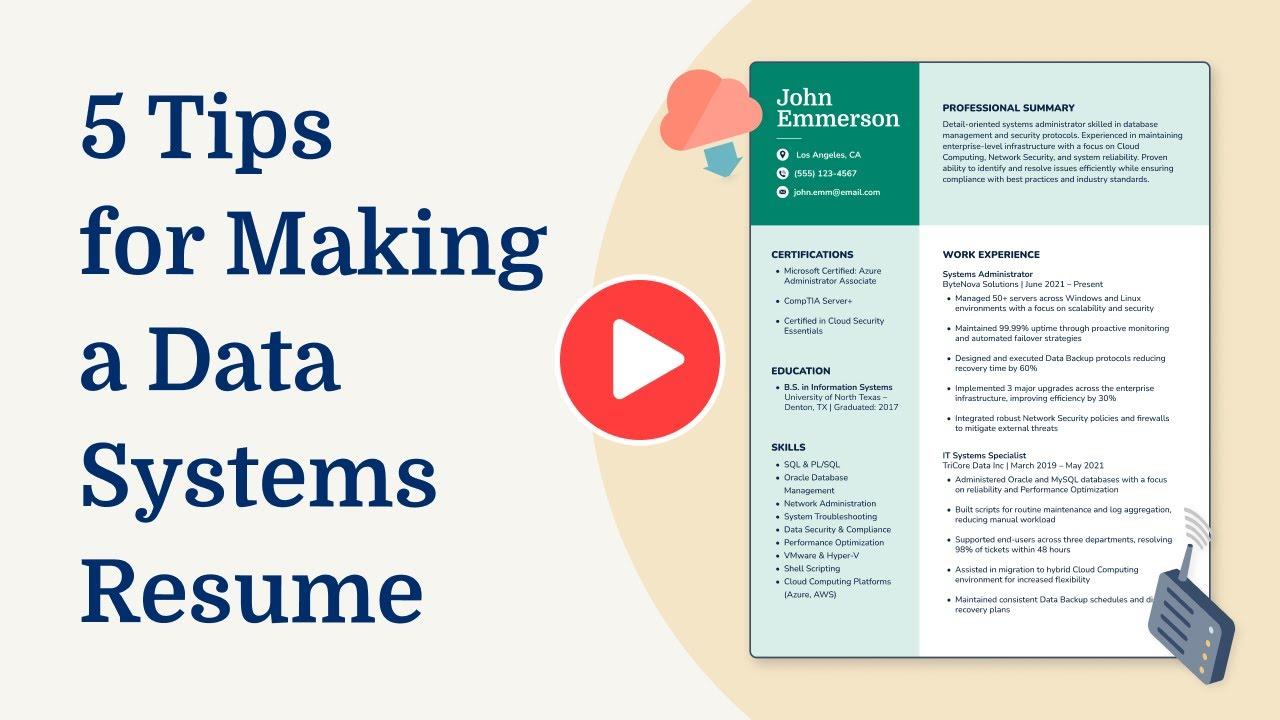
Highlight relevant technical skills
For a data systems administration role, technical skills are key. These skills help you manage and secure data systems, ensuring they run smoothly and efficiently. Consider creating a dedicated section for your technical skills in your resume. This way, you can list the tools and technologies you’re familiar with. If you’ve used these skills in past jobs, weave them into your work experience section too.
Typical technical skills for data systems administration include database management systems like SQL or Oracle. You’ll also want to know operating systems such as Linux or Windows Server. Knowledge of network protocols and security measures is important too. Including programming languages like Python or Java can be beneficial since they’re often used for automation tasks.
When listing your skills, focus on what matches the job requirements you’re applying for. Highlight any specific software or tools mentioned in the job description that you know well. Tailoring your resume this way shows potential employers that you’re prepared for the role and understand what’s needed to succeed in data systems administration tasks.
Example of a technical skills section
- Database management (MySQL, PostgreSQL, MongoDB)
- Cloud services (AWS, Azure, Google Cloud Platform)
- Data integration & ETL tools (Informatica, Talend, Apache NiFi)
- Operating systems (Linux, Windows Server, Unix)
- Scripting languages (Python, Bash, PowerShell)
- Virtualization technologies (VMware, Hyper-V)
- Network configuration & security
- Backup and recovery solutions
- Performance tuning & optimization
- Monitoring tools (Nagios, Zabbix)
You can use our Resume Builder to craft a resume that highlights technical skills in addition to key soft skills like teamwork, communication, and adaptability.
Quantify your accomplishments
Quantifying accomplishments on a resume is an effective way to stand out. Instead of just listing what you did in your job, show how well you did it by including numbers and results.
For example, if you’re working in data systems administration, don’t just say you managed databases; mention that you reduced downtime by 20% or saved the company $10,000 by optimizing storage solutions. This approach helps hiring managers see your impact and skills quickly.
When writing the work experience section for data systems administration, make sure each entry has the job title, employer name, location, and employment dates. Then, turn regular duties into achievements by using action verbs with measurable results.
Say “improved system efficiency by implementing new protocols” instead of simply “implemented new protocols.” This turns your resume into a story about success rather than just a list of tasks.
By quantifying accomplishments with metrics like percentages or cost savings, your resume becomes more results-driven. This makes it easier for employers to understand what you can bring to their team. It shows them at a glance why they should consider you for their open position in data systems administration.
5 data systems administration work history bullet points
- Managed data systems integration projects, improving data accuracy and reducing errors by 25%.
- Implemented automated backup solutions, improving data recovery speed by 40% and minimizing downtime.
- Optimized database performance, resulting in a 30% increase in query efficiency and faster response times.
- Led a team of 4 administrators to migrate legacy systems to cloud-based platforms, cutting operational costs by 15%.
- Developed security protocols for data access, decreasing unauthorized access incidents by 50%.
Want to make your resume stand out? Check out our professional resume examples for ideas on highlighting your skills and qualifications.
Write a powerful professional summary
A professional summary acts as a snapshot of your career, providing hiring managers with an immediate overview of your qualifications. It sets the stage for your resume and helps them decide quickly if you’re a good fit for the role. When crafting this section, consider using action-oriented language to highlight your skills and impact on previous roles.
A professional summary is typically three to four sentences that showcase your experience, skills, and achievements. It’s most suitable for individuals who have substantial work experience in their field. Its purpose is to convey your professional identity and demonstrate the value you bring to potential employers.
In contrast, a resume objective focuses on career goals rather than past accomplishments. It’s ideal for entry-level applicants, those changing careers, or individuals with employment gaps. Think of it as stating “what I aim to contribute” compared to “what I’ve accomplished.”
Next, we’ll look at examples of both summaries and objectives tailored to various industries and levels of experience.
Data systems administration resume summary examples
Entry-level
Recent data systems administration graduate with a Bachelor of Science in Information Technology and foundational skills in database management and network configuration. Holds CompTIA A+ certification, demonstrating a strong understanding of technical support and system troubleshooting. Eager to apply educational knowledge to assist teams in maintaining efficient data systems operations.
Mid-career
Data systems administrator with 5+ years of experience managing enterprise-level databases and IT infrastructure. Proven track record in optimizing system performance, implementing security protocols, and supporting cloud solutions. Experienced in SQL, Linux server management, and known for effective problem-solving capabilities that improve productivity across departments.
Experienced
Seasoned data systems administrator specializing in strategic planning and execution of complex IT projects. Brings over a decade of expertise in virtualization technologies, cybersecurity frameworks, and disaster recovery strategies. Recognized for leadership in driving technological innovation, improving data integrity, and achieving significant cost savings through process automation.
Data systems administration resume objective examples
Entry-level
Detail-oriented and tech-savvy individual with a Bachelor’s degree in information technology seeking an entry-level data systems administration role to use foundational knowledge in database management and network configurations. Eager to support system efficiency and security in a collaborative IT environment.
Career changer
Resourceful professional transitioning from customer service to data systems administration, bringing strong problem-solving skills and experience with CRM software. Looking to contribute analytical abilities and a keen interest in IT infrastructure to improve organizational data operations.
Recent graduate
Recent computer science graduate with hands-on experience in cloud computing and cybersecurity through academic projects. Aiming for a junior data systems administrator position to apply technical skills in maintaining robust data environments while gaining industry experience.
Choose a simple resume template with clear headings, easy-to-read fonts, and plenty of white space. Avoid flashy colors or designs to make your experience stand out better.
Showcase your credentials
In data systems administration, certifications validate your expertise with essential tools, platforms, and best practices—helping your resume stand out in a competitive field.
A dedicated certifications section makes these credentials easy to find and demonstrates your commitment to staying current with rapidly evolving technologies. Placing this section alongside your education creates a complete picture of your technical capabilities. Examples of valuable certifications include:
- AWS Certified Solutions Architect
- Google Professional Cloud Engineer
- Microsoft Certified: Azure Solutions Architect Expert
- Certified Kubernetes Administrator (CKA)
- CompTIA Security+
These certifications show you’re prepared to handle advanced responsibilities like managing cloud environments, securing data infrastructures, and optimizing system performance. They signal to employers that you’ve invested in mastering technologies critical to efficient and secure data systems administration.
Example of a certifications section
Microsoft Certified: Azure Database Administrator Associate
Issued by: Microsoft
Issued 2022
AWS Certified Database – Specialty
Issued by: Amazon Web Services (AWS)
Expires 2024
Oracle Database Administration Certified Professional
Issued by: Oracle
Issued 2021
Certified Information Systems Security Professional (CISSP)
Issued by: (ISC)²
Expires 2025
Red Hat Certified System Administrator (RHCSA)
Issued by: Red Hat
Issued 2023
Use a polished and professional resume format that aligns with your experience level to ensure your skills and qualifications stand out to hiring managers.
FAQ
Do I need to include a cover letter with my data systems administration resume?
Yes, adding a cover letter to your data systems administration resume can be beneficial. It gives you a chance to highlight your technical skills and enthusiasm for the job, while also explaining why you’re a great fit for the company.
You can use our Cover Letter Generator to address specific technologies or platforms mentioned in the job posting that you have experience with, such as SQL databases or cloud services.
Additionally, if there’s a project or achievement that’s particularly relevant but not fully covered in your resume, this is an excellent place to elaborate. Explore cover letter examples tailored to tech roles to help guide the structure and content of your letter.
How long should a data systems administration resume be?
For a data systems administration role, aim for a one-page resume if you’re early in your career. This length lets you spotlight key skills like system management, database oversight, and troubleshooting.
If you have extensive experience or specialized certifications, a two-page resume can be fitting. Ensure every detail is relevant, showcasing achievements in optimizing data systems and recent roles that show expertise.
For more tips on finding the right length for different career stages, check out our guide on how long a resume should be.
How do you write a data systems administration resume with no experience?
Creating a data systems administration resume can be tricky if you’re new to the field, but focusing on your skills, education, and relevant projects is key. Here are a few tips to help you get started:
- Emphasize your technical skills: List specific software and programming languages you’re familiar with, like SQL, Python, or database management systems. Highlight any IT certifications you may have acquired.
- Showcase relevant coursework: If you’ve taken classes in computer science, information technology, or data management, list these to demonstrate foundational knowledge. Include any significant projects where you applied these skills.
- Include internships or volunteer work: Even if unpaid, experiences where you’ve managed data or supported IT operations can be valuable. Detail what you did and the tools you used during these experiences.
- Highlight soft skills: Mention problem-solving abilities, attention to detail, and communication skills. These are important for managing complex data systems and collaborating with teams.
Check out this guide on crafting a resume with no experience to further improve your application with expert tips tailored for aspiring system administrators.
Rate this article
Data Systems Administration
Additional Resources

Gen Z Job Market Trends: Data Reveals College Graduate Unemployment Rate Is on the Rise
A college degree has long been seen as the ticket to better pay, career stability, and increased employment opportunities. But for today’s graduates, that promise is slipping away. Research from the
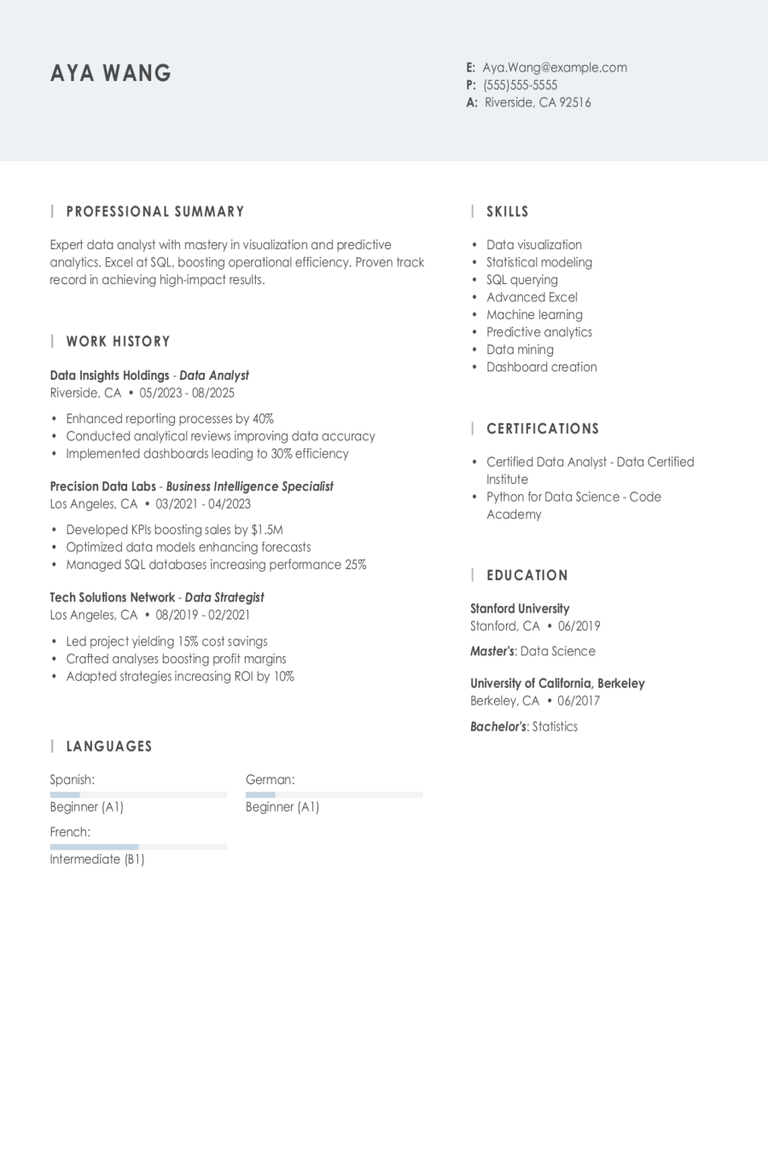
Data Analyst Resume Examples & Templates for 2025
Discover top data analyst resume examples that show how to highlight your skills in data collection and analysis.Build my resumeImport existing resumeCustomize this templateWhy this resume worksQuantifies accomplishments: By showcasing
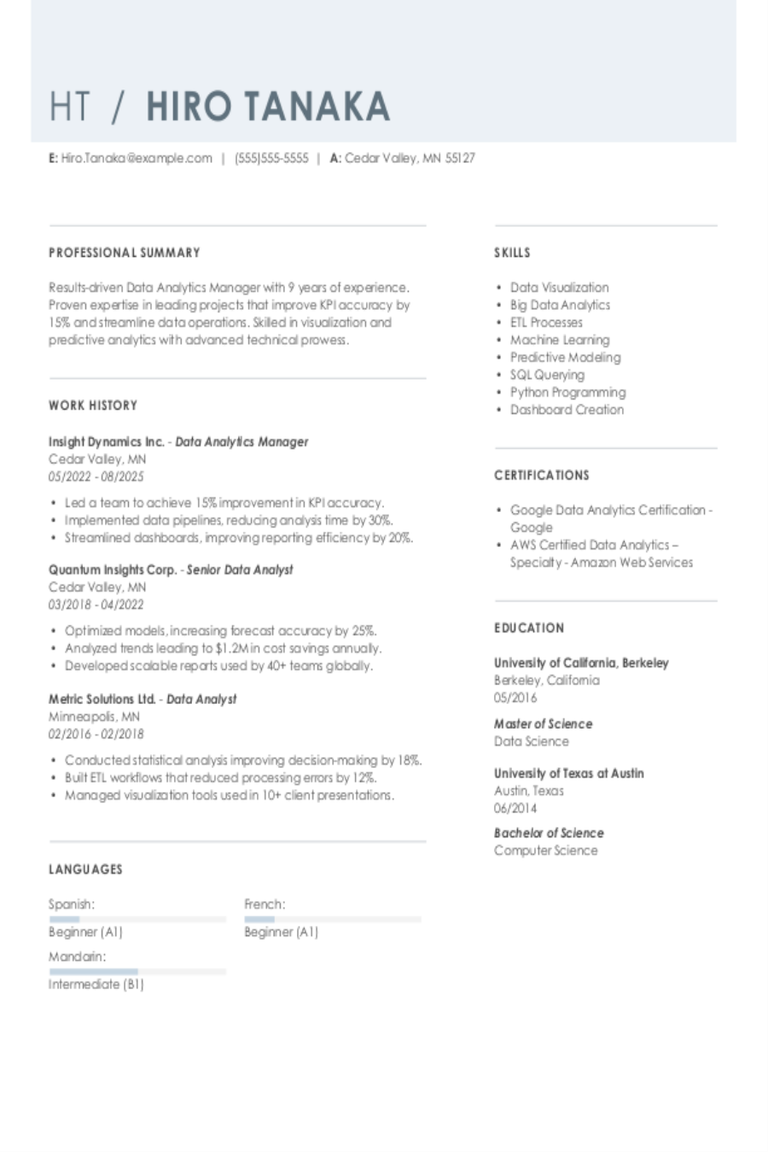
Data Analytics Manager Resume Examples & Templates for 2025
Explore data analytics manager resume examples that focus on teamwork, problem-solving, and using data tools. See how to show you’re skilled in leading projects and turning data into insights.Build my

Systems Analyst Resume Examples & Templates for 2025
Explore systems analyst resume examples and tips to learn how to highlight your tech skills, problem-solving abilities, and experience working with data and software systems.Build my resumeImport existing resumeCustomize this
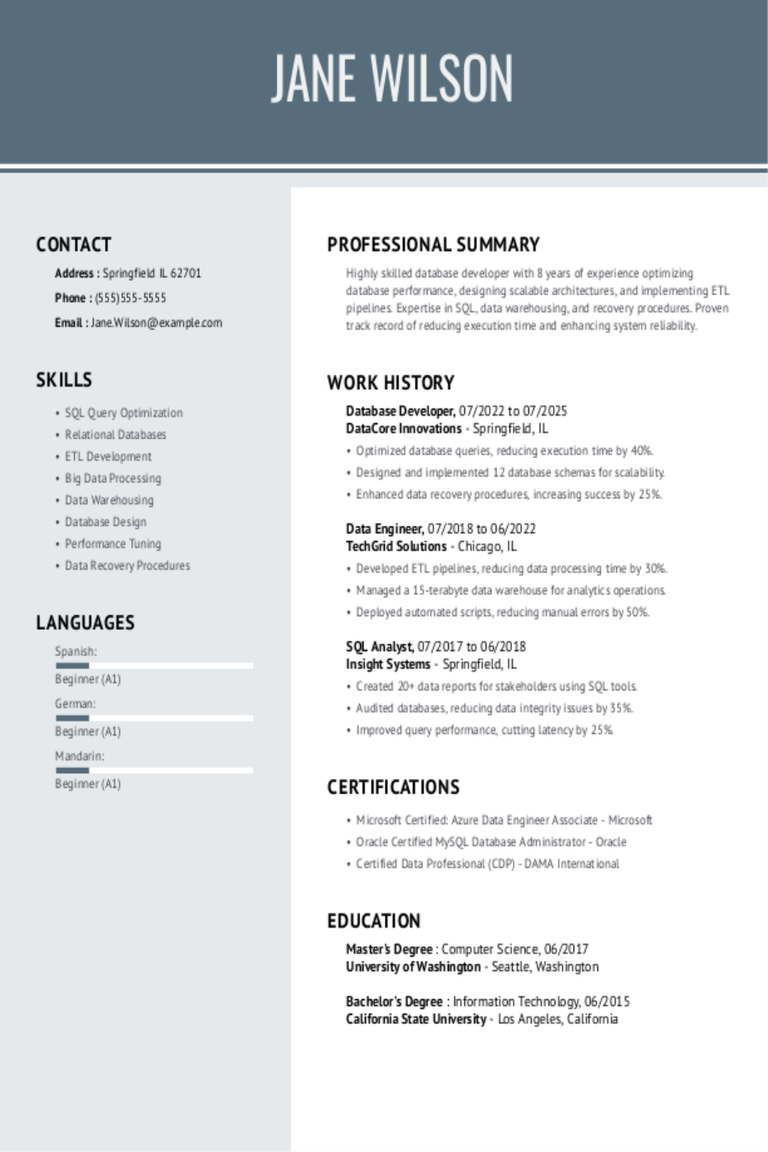
Database Developer Resume Examples & Templates for 2025
As a database developer, your resume needs to highlight your ability to design, manage, and optimize databases. Learn to showcase your technical skills and past projects to stand out in
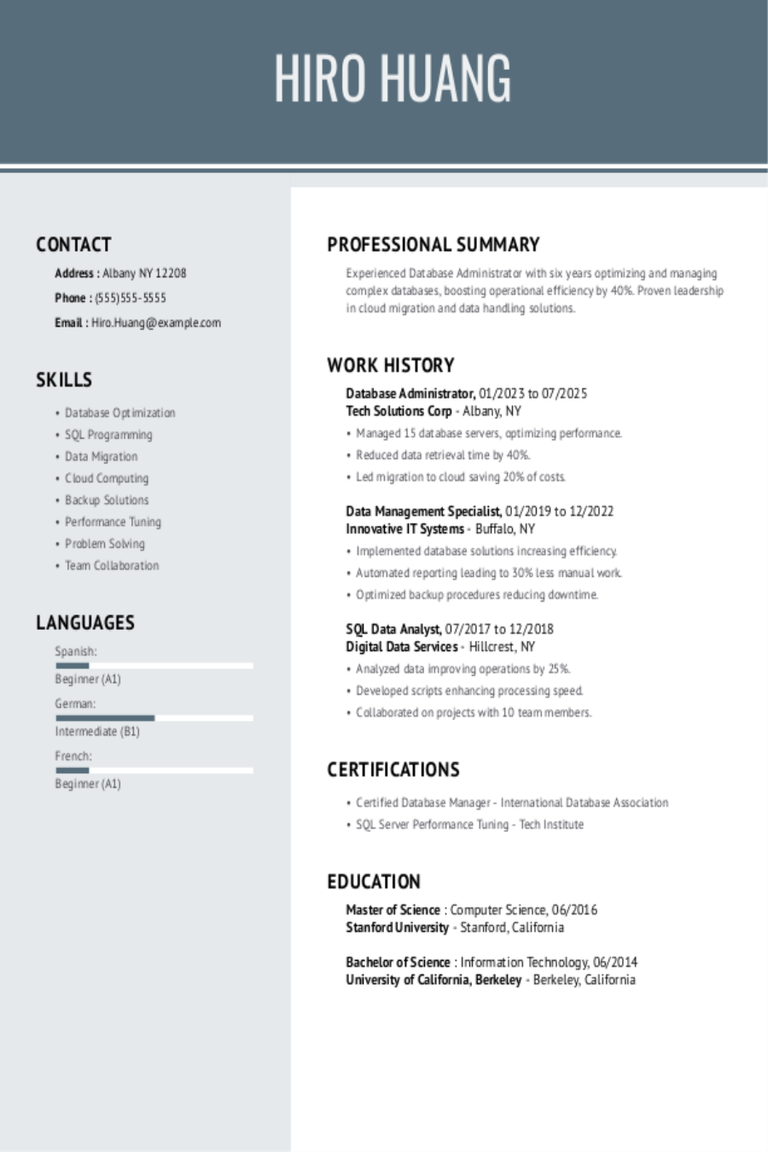
Database Administrator Resume Examples & Templates for 2025
Discover great database administrator resume examples that help you understand how to highlight your tech know-how and management skills. Learn how to showcase your experience with databases and impress hiring
